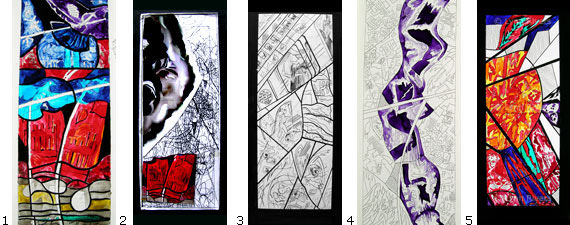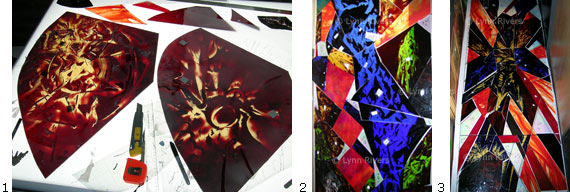
Design & Making
|
This section contains The Design Process, FAQs: How did you Make the Images in Glass? and a discussion of the relationship between Glass & Photography. |
The design process occupied about two-thirds of the total project time. As the subject matter evolved alongside philosophical and art historical explorations, (more...), scaled-down designs were drawn. The colour pathways were explored and thoroughly tested, from initial ideas, to colour matching the flashed and the abstract glass as it was being purchased or made specifically for the work. Part of selecting the abstract glass was to choose appropriate patterning (more...). The use of lead was chosen to contain the images. The dynamics of the lead lines and hence the glass shapes were an integral part of the design process from the outset to the finished panels. The panels were designed as a glass installation with every materialsí relevance carefully considered.
It was an interesting discipline knowing that I had designs at earlier stages that could have been realised in glass but maintaining the resolve to continue designing until I was absolutely convinced it was the idea I sought.
Design ideas

1. Panel 9: early idea for stand alone panel.
2. Panel 9: early idea with chaos influence by Georg Miesterman
3. Early stand alone panel about hijacked planes and firemen ascending into building
4. Early idea, influence by Jasper Johns
5. Final colour Acetate visual.
There are many more aspects that the artist is willing to discuss, these will appear in forthcoming publications. If you are interested to find out more, please contact the artist.
FAQís: Glass How did you Make the Images in the Glass?
The glass sheets are made with two layers of different coloured glass, one layer is between 3-5mm and the other is about 1mm thick, this is known as flashed glass. An image is drawn on masking film, which is then stuck on to the thin-layer side of the glass. The image on the masking film is then cut around with a scalpel and parts removed. This side of the sheet of glass is then sandblasted, which removes the thin layer to reveal the image. The thin-layer side of the glass is then reversed so that viewing occurs through a continuous glass surface.

1. Piece of glass with masking film image ready for sandblasting.
2. Close up detail of sandblasted red on yellow glass. The darker three bands are the red un-blasted area.
3. Reverse of piece of glass that is being assessed after the majority sandblasting completed.
4. Final image and obverse of glass in image 3.
There are endless variations of a single colour on clear glass available, e.g. red on clear, blue on clear, amber on clear, etc. Two-colour flashed glass works similarly but enables an extended colour range. For example, with a red on yellow flashed glass, if you donít sandblast all the thin red layer away, then you obtain orange. The variation in colours is thus finely controlled with the pressure, time, size, and type of the sandblasting grit. Removing parts of the masking film at the right time is another vital skill.
- There were 1,000ís of hours put into drawing, drawing the ideas with a pencil and then drawing with a scalpel to make the image in the glass.
- It is straightforward, that if the glass is overblasted, which can happen in a fraction of a second, you canít put it back.
- Out of all the glass used for this work I only wasted two small pieces and one of these was a new colour I hadnít tried before where the colour was much softer than any other used to date.
Each of the pieces of glass was sandblasted in one session with immediate assessment being made on a lightbox next to the sandblaster, with panel-sized light boxes used for the next stage of assessment/assembly. There were exceptions, the apple pieces were the most notable because of their size, depth of colour, weight, and cost of this unique glass, this meant that it took longer with all stages. The continuous image across several pieces of glass in Panel 8 is another example. The depth of colour required in all the pieces used in Moment of Impact 9/11 have been selected specifically from the small batches of glass, and from limited stocks because of their cost.

1. The two halves of the fragmented apple, nearing completion of sandblasting.
2. Top section of Panel 8 on lightbox.
3. Panel 5 nearing completion of images, on lightbox, before leading.
Throughout the making of the artwork, the public, when visiting my studio space, were desperate to touch the image, it is after all an inherent sensory trait of human beings. This could have been a problem because grease from the human skin once imprinted is virtually impossible to remove from the glass structure. There are many options that can be taken to protect the glass in respect of long-term display.
Prior to working in glass, I worked as a photographer specialising in close-up photography. I was fascinated how the analysis of small details was being investigated within archaeology and forensics to build a greater understanding of larger, past events. My first encounter with flashed glass instantly confirmed its potential; I could draw millimetre detail and sandblast that into the glass. One such detail of the 300 images includes a life-size image of a mobile phone with the alphabet on the keypad and a text message on the screen.
Another significant similarity was the colour intensity of the flashed glass to that of photographic transparencies and that this vibrancy reflected the city. Also, photographic work involves making endless decisions about the right moment to make an image. Knowing when the image is fully realised, the photographer Cartier Bresson famously called it the Ďdecisive momentí, I am sure informed the sandblasting of the images.
When I originally trained in photography in Salisbury, Wiltshire, I spent a lot of time in ecclesiastical buildings that contained a whole range of materials that required different photographic techniques. I could watch light as it moved around the building and the glass/light interaction was obviously part of this experience. I frequently visited Salisbury Cathedral and in particular the Prisoners of Conscience window by Gabriel Loire. (more...). Two main factors particularly attracted me to the work, the complexity of the visual design and the experience of blue glass. In terms of subject matter, it was the outside lancet windows that were of greatest interest to me for they were dedicated to all those who had chosen to make a stand for human rights and human values in spite of the personal loss they would be dealt. Once I embarked on Moment of Impact 9/11 I revisited Salisbury Cathedral and other British cathedrals notable for glass: Coventry Cathedral and the Catholic Cathedral in Liverpool. It is the stained glass of most notably the German artist Georg Meistermann and others who were influenced by the dynamic use of lead work that I found exciting. link: Art Influences 7. Meistermann
However, I most admire contemporary work, especially fine art painting, drawing and sculpture. The sculptural glass work by Mary Kline in which she incorporates photosensitive glass is of particular interest. Also, I have great admiration for the work of William Morris, the glassmaker, whose subject matter links to my interest in archaeological artefacts. His poignant Cinerary Urns is a major piece of work dedicated to the victims of 9/11.
If you are interested to find out more, please contact the artist
Moment of Impact 9/11 is now seeking a permanent home contact us.